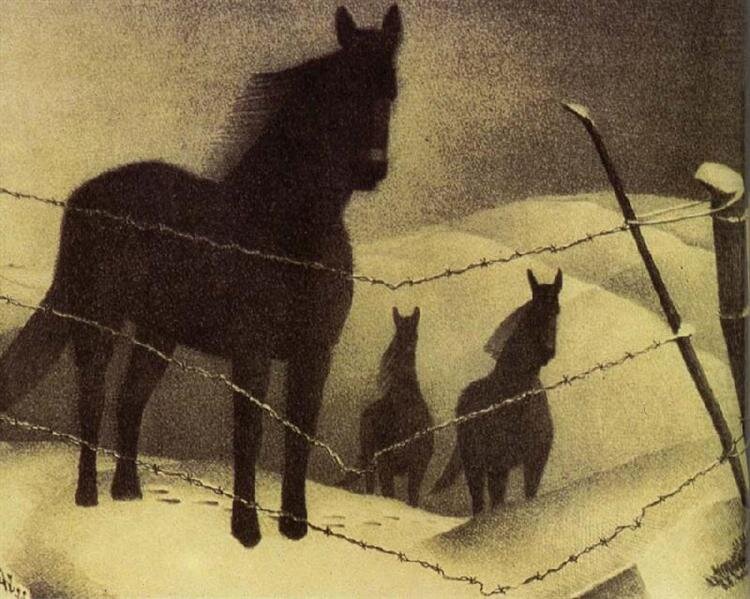Floral Shapes
Photo via Worthpoint
Your Custom Text Here

Photo via Worthpoint

February, 1940 by Grant Wood.
Wood came to appreciate lithography as a medium late in his career. Many of his lithographic works were offered through the Associated American Artists project that offered the artistic names of the day through the mail for as little as $5.00.

The Bather of Valpincon by Jean Auguste Dominique Ingres.
Ingres' skill at portraying drapery and textiles was the best of the 19th Century French Classical artists. He was inspired by the Italian Renaissance painter Raphael whose clear straightforward yet lush style made his influence third after the Renaissance giants Michelangelo and Leonardo.

Acacias, c.1880 by Albert Moore.
Moore was influenced by the Elgin Marbles (Parthenon statuary which had recently arrived in London at the British Museum - where they remain and are the source of much controversy).

Watson and the Shark, 1777 by John Singleton Copley.
Copley's historical painting tells a story about Brook Watson who would survive the attack and go on to become Lord Mayor of London.

Return of the Sun, 1986 by Odd Nerdrum.
Nerdrum is an artist whose influence lies in classic artists like Rembrandt, who prefers to mix his own paints and stretch his own canvases. He draws upon a knowledge of art history to create his work - he has done his homework and reveres those that have come before him, paying them homage and respecting history.

Venus, c.1984 by Andy Warhol, various collections.
Warhol was one of the most successful artists to come out of the Pop movement in America. His use of everyday images gave people something to relate to.

Botticelli, Birth of Venus, 1485-86

A Bar at the Folies Bergere, 1881-82 by Edouard Manet.
Manet's last major painting. At first glance you see the bored looking barmaid staring off into the distance. Upon closer inspection we can see all the activity of the bar going on in the mirror. Including a patron whose presence is not doing anything to improve her mood - perhaps he caused the mood? Those tangerines just jump out at you, don't they?

Waiting (L'Attente) by Edgar Degas.
Degas' paintings of the life that goes on behind the scenes at the ballet are among his most beloved because they are real and show what went on, not just the finished product on the stage. We see the dancers trying to stay limber, the chaperones trying to stay awake, caught by an artist who managed to blend into the woodwork to bring us their world.

Jesus Loves Me by Varnette Honeywood.
Honeywood's flat one dimensional style and strong colors give her work a unique look. She has done a lot of book illustrations, for which her technique is very well suited. Honeywood's work captures the varied experiences of African Americans and celebrates the relationships and traditions that bond the people and communities.

La Joconde (Mona Lisa), 1749-1828 by Leonardo da Vinci, The Louvre.
That mysterious smile, many words have been written about it and its meaning, could it be a matter of

The Treachery of Images by Rene Magritte.
Surrealist Magritte has written "This is not a pipe" underneath an image of a pipe. His point is to remind the viewer that although you might be tempted to call this a pipe when you see it, is just a painting of a pipe.

Mount Sainte-Victoire, 1904-1906 by Paul Cézanne, Philadelphia Museum of Art.
Cézanne is considered to be the father of modern painting. His use of loose brush strokes and flattened planes led to Impressionism and Cubism. His bright palette influenced the Fauvist painters, as well.

Justice, c. 1970 by Erte
A more modern take on Lady Justice.

Le chat (The Cat at the Window), 1857-58 by Jean Francois Millet.
Millet's illustration of "The Cat Who Became a Woman," a fable by the seventeenth-century French writer Jean de La Fontaine. According to the story, a man becomes infatuated with his cat and convinces Destiny to change her into a woman. He marries her, but on their first night together she springs from the marriage bed to chase a mouse across the bedroom floor. The fable's moral is "The truth will out": no matter how much one's outward appearance changes, one's essential character remains.

L'etoile [La danseuse sur la scene] (The Star [Dancer on Stage]) 1878, by Edgar Degas.
Degas did a large series of paintings and sculptures of ballet dancers, all levels of dancers and on the stage and behind the scenes. When I was a child, a print of this painting was in my bedroom. I remember the eyes freaked me out because they were all black.

Iris Tree by Augustus John.
Tree was a poet and artist’s model probably better known in a famous portrait by Amedeo Modigliani. John had a very robust career being one of the most well known artists in the UK in the early 20th century.

Iris Tree by Armedo Modigliani c. 1916

The Precious Book , c.1920 by Gwen John.
John studied under James McNeill Whistler in Paris and at the Slade School in London where she developed her agitated style. Her brother Augustus John was also a painter and quite popular during his day, overshadowing his older sister.

Vase of Flowers, c. 1900-16 by Odilon Redon, MoMA.
Although primarily known as a Symbolist artist Redon created a number of floral still life paintings in his career. They all have a stark quality that allows the beauty of the flowers to be the focal point.

Mystery of the Missing Migrants by Charley Harper, various galleries.
Charley Harper is best known for his book illustrations from the mid 20th century.